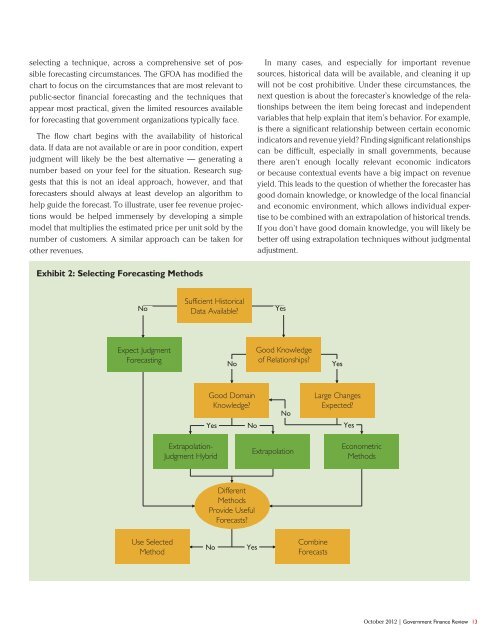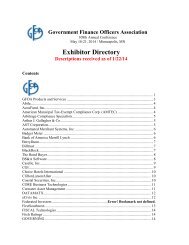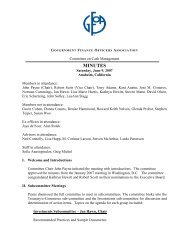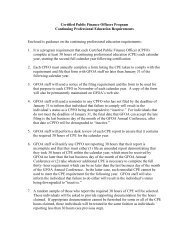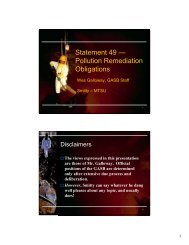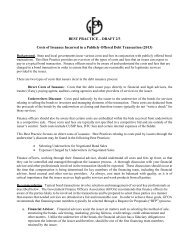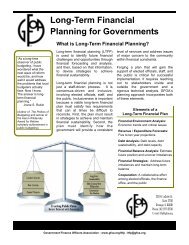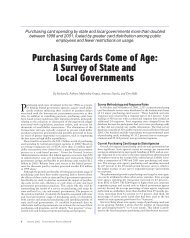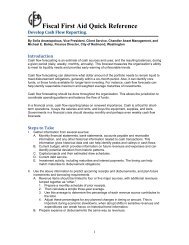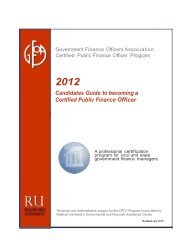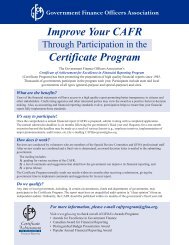Structuring the Revenue Forecasting Process - Government Finance ...
Structuring the Revenue Forecasting Process - Government Finance ...
Structuring the Revenue Forecasting Process - Government Finance ...
Create successful ePaper yourself
Turn your PDF publications into a flip-book with our unique Google optimized e-Paper software.
selecting a technique, across a comprehensive set of possible<br />
forecasting circumstances. The GFOA has modified <strong>the</strong><br />
chart to focus on <strong>the</strong> circumstances that are most relevant to<br />
public-sector financial forecasting and <strong>the</strong> techniques that<br />
appear most practical, given <strong>the</strong> limited resources available<br />
for forecasting that government organizations typically face.<br />
The flow chart begins with <strong>the</strong> availability of historical<br />
data. If data are not available or are in poor condition, expert<br />
judgment will likely be <strong>the</strong> best alternative — generating a<br />
number based on your feel for <strong>the</strong> situation. Research suggests<br />
that this is not an ideal approach, however, and that<br />
forecasters should always at least develop an algorithm to<br />
help guide <strong>the</strong> forecast. To illustrate, user fee revenue projections<br />
would be helped immensely by developing a simple<br />
model that multiplies <strong>the</strong> estimated price per unit sold by <strong>the</strong><br />
number of customers. A similar approach can be taken for<br />
o<strong>the</strong>r revenues.<br />
In many cases, and especially for important revenue<br />
sources, historical data will be available, and cleaning it up<br />
will not be cost prohibitive. Under <strong>the</strong>se circumstances, <strong>the</strong><br />
next question is about <strong>the</strong> forecaster’s knowledge of <strong>the</strong> relationships<br />
between <strong>the</strong> item being forecast and independent<br />
variables that help explain that item’s behavior. For example,<br />
is <strong>the</strong>re a significant relationship between certain economic<br />
indicators and revenue yield? Finding significant relationships<br />
can be difficult, especially in small governments, because<br />
<strong>the</strong>re aren’t enough locally relevant economic indicators<br />
or because contextual events have a big impact on revenue<br />
yield. This leads to <strong>the</strong> question of whe<strong>the</strong>r <strong>the</strong> forecaster has<br />
good domain knowledge, or knowledge of <strong>the</strong> local financial<br />
and economic environment, which allows individual expertise<br />
to be combined with an extrapolation of historical trends.<br />
If you don’t have good domain knowledge, you will likely be<br />
better off using extrapolation techniques without judgmental<br />
adjustment.<br />
Exhibit 2: Selecting <strong>Forecasting</strong> Methods<br />
No<br />
Sufficient Historical<br />
Data Available?<br />
Yes<br />
Expect Judgment<br />
<strong>Forecasting</strong><br />
No<br />
Good Knowledge<br />
of Relationships?<br />
Yes<br />
Good Domain<br />
Knowledge?<br />
Yes<br />
No<br />
No<br />
Large Changes<br />
Expected?<br />
Yes<br />
Extrapolation-<br />
Judgment Hybrid<br />
Extrapolation<br />
Econometric<br />
Methods<br />
Different<br />
Methods<br />
Provide Useful<br />
Forecasts?<br />
Use Selected<br />
Method<br />
No<br />
Yes<br />
Combine<br />
Forecasts<br />
October 2012 | <strong>Government</strong> <strong>Finance</strong> Review 13


